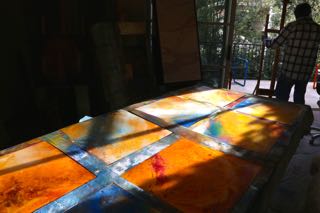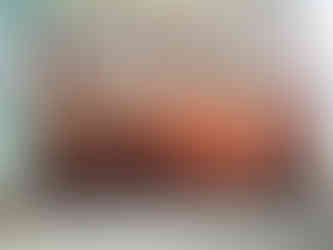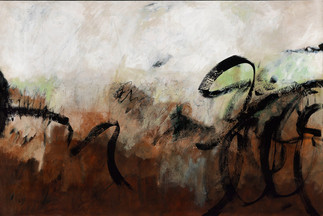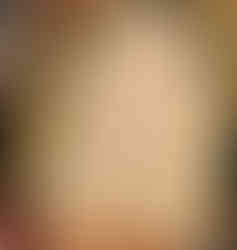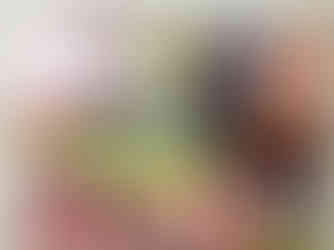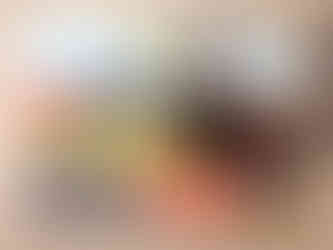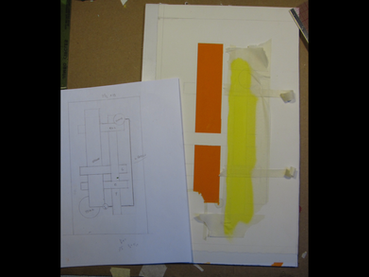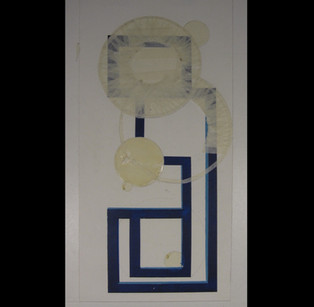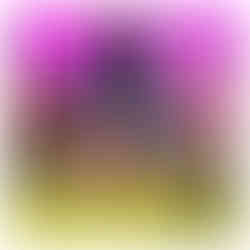The Evolution of an abstract:
- Jennifer Gillia Cutshall

- Sep 22, 2021
- 6 min read
Snapshots, time-lapse videos, & Insights from the Abstract Catalyst artists
Austin Irving
"Abstraction has absolutely been a catalyst for me, especially within the context of the work included in this show. Making large format analog photographs is a ritual that helps me make sense of the world and, as I discovered, a way to make visible the hidden aspects of myself that would otherwise remain occluded - visual
clues into my inner landscape.
In early 2017, the power of my practice to illuminate subterranean currents of internal dissonance, and ultimately initiate self-healing, became apparent via a photographic series aptly entitled: CORNERED, which debuted in Los Angeles in 2018. I realized that these images were visual representations of body dysmorphic disorder: a corporeal prison in which I was trapped. As this revelation dawned on me, I revisited my previous work and noticed that many of my projects have not only been about investigating tensions that exist in physical environments, but also a subconscious investigation of the veiled inner friction I was experiencing but could not yet articulate."
Austin Irving

Stephanie E. Kolpy
"Abstraction has the ability to get to the emotive core of a subject matter. In my process of building a composition, it's the act of creating the intricate areas of abstraction that give me time to reflect and meditate on what the work is about. I find these passages of abstraction happen in a cathartic and spontaneous focus on detail with in and around the recognizable forms. At its best, this abstraction that happens in my process of creating becomes the unity of the visual forms and adds the emotive quality to the visual language of my work."

The recognizable elements I begin with are almost expected or predictable, but the abstraction of these elements and their atmosphere is unpredictable to even me, never planned. Yet these abstract passages really become the catalyst for emotion, movement and the visual language that is undefinable.
I think for me, abstraction makes the invisible more visible but makes the undefinable through any other language visible as well." Stephanie E. Kolpy
Christian Hires
Timelapse window (above) into the work of Abstract Catalyst artist, Christian Hires.
And Christian Hires at work...

Walter Jakubowski
"Having always been fascinated with life’s mysteries that often lie outside of our culture’s established norms, I find that abstraction departs from the prosaic to challenge our perceptions of our everyday world. My passion is to create images that to me are compelling, both emotionally and visually, endeavoring to provide a portal for transmuting the temporal to the empyreal.

This image is initially a found capture of paint; cracked, flaked or otherwise deteriorating on rusting metal. The textures are inherent and the colors and tonality are the result of my initial and subsequent response to the subject matter."
Walter Jakubowski
Diana Kogos
"Inspired by patterns in nature, my work transforms flat surfaces into three-dimensional spaces through an interplay of lines, values, and shapes." Diana Kogos
Virginia Bledsoe
"There are so many possibilities in abstraction and what I like most about is the exploration.

I have never been interested in capturing something that already exists. I would rather play with shapes, color, and design. I do not title my pieces, because I think nouns interfere with the purely visual nature of non-objective artwork. The piece that I submitted to the show was part of a series of 8”x 8” black, white, and gray, mixed media, collage, works on paper. Layering andcollage play a big part in this series."
Virginia Bledsoe

Shawn Marie Hardy
"A primary school teacher once criticized me for coloring outside the lines on a coloring page and it ingrained a certain lack of confidence that I carried over decades. I have slowly broken free from those demons to where I feel comfortable creating my own rules. This is a world of my choosing."
Shawn Marie Hardy

William Ishmael
"I am a student of spiritual thought, quantum physics, Buddhism, and meditation...
I am seldom able to articulate what I understand about how these topics play together – but when I am creating artworks, I’m often thinking about these concepts. I always have a direction I want to take the work, and I’ve enough experience with the materials I use to know where I want to head, but I’m always sensitive to how the materials are interacting on the surface and adjust when I see something beautiful or interesting developing."
William Ishmael

James Long
"Essentially process is the think, perhaps it's intuitive, or an indefinable aspect relying on chance. Digital Media embodies a freedom to explore undiscovered elements, thoughtfully, assuredly, disregarding reality, the process evolves thru study of form, color, texture and scale, in pursuit of the impalpable, the result justifies the think."
James Long

Liz Thoresen
"The stimulus for painting an abstract is the self-discovery it brings as I
layer paint and apply texture while balancing shapes, lines, and color.
My prompts are often inspirational lines from a book, song, or poem.
Many times they are my emotional responses to current events. Starting with words written on a substrate, I am surprised and energized with what transpires and appears on the canvas as the painting progresses. The unexpected is my goal. Abstracts allow for total immersion, unconstrained by a preconceived image. It is this conversation with the unknown that excites me and keeps me painting
over and over."
Liz Thoresen

Jens Vange
"My concept, “Hidden Dimensions of Urban Architecture,” is about discovering the inner life of buildings. They move and breathe as air pressure and temperature flux. Their skin expands and contracts, distorting its surroundings into abstract, organic forms.

Rather than simply photograph a building, I capture it through interpretive reflections in its neighbors. This often involves stepping inches in every direction until a moment is revealed."
Jens Vange

Mona Monroe
"The process. After gessoing the wooden panel, I start with some kind of overall imagery. Lately that’s been asemic writing, which may or may not appear in the final piece. Areas are blocked out with masking tape and collage elements are added. Oil mixed with cold wax is layered, and materials are added and subtracted, revealing and obscuring the mark making. I’m reaching out and grabbing all those thoughts flying around in my head and giving them existence. I want the viewer to find their own meaning. I also love the physicality of painting."
Mona Monroe

Debra Jan Bibel
"As a Medical scientist and artist I perceive the world as functional forms, morphologies, and reduces shapes to their geometric ideals.

My exact scale cityscape series were first skylines and oblique scenes and now provide a vertical perspective where the patterns of reality become fully abstract. I use bold, saturated colors enhance the effect. The exhibited work, East Oakland Choreography, is a bird's-eye/satellite view of a neighborhood of the California city; the lines and hues create a portrait of the urban spirit." Debra Jan Bibel
Dianne Jean Erickson
"In most cases, my approach to abstract and non-objective art is to apply acrylic paint with no thought to what the final piece will be and to see where the first applications lead. At some point I switch to oil & cold wax and become more aware of the possibilities, which are usually many, and start to make decisions on which direction I feel will lead to an interesting piece. In approaching the painting in this way I find interesting and fulfilling paintings that I could not have discovered by planning beforehand. I love working this way!" Dianne Jean Erickson

Earl Grenville Killeen
"When I was on the cusp of a sea change in the subject matter of my paintings, I took an unaccustomed turn at abstraction (albeit mostly geometrically structured) as a “palette cleanser” (pun intended). This stint in the non-representational realm had the hoped-for effect of loosening my style along with my spirit, enabling my brushwork to be more impressionistic and my imagery more overtly personal. The painting that appears in “Abstract Catalyst” is the first in this new series (“Out of This Soul”), and is like the curtain I peeped or passed through to get from the metaphorical rendering of, first, inanimate objects and then small bits of Nature to dealing with memory, emotion, and engagement with the world in my own human form."
Earl Grenville Killeen

James Hockenhull
"If I were to start off drawing a puppy-dog I’d have a pretty good idea of when I’d drawn a puppy-dog. When I begin with no specific destination in mind, and no specific way to get there, the whole world of possibilities opens up. I like working with unbridled, exuberant potential. I like it very much. Art is like alchemy: when you finally can change base material into gold, you find that the journey wasn’t about that at all but about what has happened to you along the way."
James Hockenhull

Barbara Marshall
"My photography turned more toward abstract in 2011 while on a daily walk. I looked down and clearly saw Snoopy and Woodstock in tar on the street.

I raced home, grabbed my camera and snapped the photo. Since then my camera is always with me as I search for TarArt photos and the unusual shot. What other people walk on or drive over as non descript tar, I often find interesting and photograph. I love to challenge my audience to see what I see."
Barbara Marshall






























